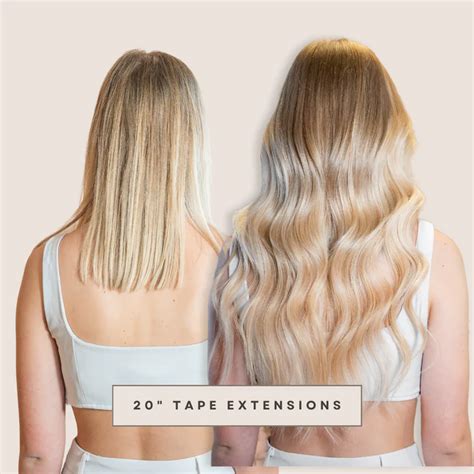Tape-in extensions, also known as “tape-ins,” have gained immense popularity as a semi-permanent hair extension technique, offering a seamless, natural look while preserving the integrity of your own hair. With tape-in extensions, you can add volume, length, and even highlights without the long-term commitment or damage associated with traditional glue-in or sew-in extensions. In this comprehensive guide, we delve into the world of tape-in extensions, exploring their benefits, types, application process, maintenance, and frequently asked questions.

Why Choose Tape-In Extensions?
Tape-in extensions have several advantages that make them an attractive option for those seeking to enhance their hair:
-
Comfort: Tape-ins are thin, lightweight, and flexible, ensuring a comfortable wear. They distribute the weight evenly across your head, eliminating any tension or discomfort.
-
Minimal Damage: Unlike other extension methods, tape-ins do not require heat or adhesives that can weaken or damage your natural hair. The tapes are gentle on your scalp and hair, making them suitable even for fine or fragile hair.
-
Versatility: Tape-ins offer a wide range of colors, textures, and lengths, enabling you to customize your look to your heart’s desire. You can go for subtle enhancements or dramatic transformations, all while maintaining a natural appearance.
-
Semi-Permanent: Tape-in extensions typically last for 6-8 weeks, providing a long-lasting solution without the need for regular maintenance appointments.
Types of Tape-In Extensions
There are two main types of tape-in extensions:
-
Single-Sided Tape: These extensions have a thin strip of adhesive tape on one side, which attaches directly to your natural hair. Single-sided tape extensions are less bulky and more comfortable to wear.
-
Double-Sided Tape: These extensions have a thin strip of adhesive tape on both sides. One side attaches to your natural hair, while the other side attaches to another extension, creating a “sandwich” effect. Double-sided tape extensions provide more secure hold and can withstand more styling manipulation.
Tape-In Extension Application
The application process for tape-in extensions is relatively straightforward, but it’s always advisable to consult a professional stylist for optimal results. Here’s a step-by-step guide to the installation process:
-
Sectioning: The stylist will divide your hair into small sections and clip away the top layers.
-
Preparation: Your natural hair will be cleaned and dried to ensure proper adhesion.
-
Tape Application: Using a specialized tool, the stylist will apply small strips of tape to your natural hair at the root area.
-
Extension Placement: The tape-in extensions will be placed on top of the tape strips and pressed firmly into place.
-
Sandwiching: For double-sided tape extensions, a second layer of tape and extension will be applied on top to create a secure hold.
-
Styling: Once the extensions are applied, your stylist will style your hair to blend seamlessly with your natural locks.
Maintenance for Tape-In Extensions
Proper maintenance is crucial to extend the lifespan and preserve the health of your tape-in extensions:
-
Regular Brushing: Gently brush your hair with a wide-toothed comb or soft bristle brush to prevent tangles and mats.
-
Washing and Conditioning: Wash your hair every 2-3 days using sulfate-free shampoos and conditioners meant for extensions. Avoid using hot water or harsh styling products.
-
Avoid Oil-Based Products: Oil-based products can loosen the adhesive and damage the tape-ins.
-
Regular Re-Taping: As the extensions grow out, the tapes may loosen and need to be reapplied by a professional stylist every 4-6 weeks.
Remodeling Tape-In Extensions
When it’s time to remove your tape-in extensions, it’s essential to visit a professional. A stylist will use a specialized solution to gently dissolve the adhesive and remove the extensions without damaging your natural hair. Avoid attempting to remove the extensions yourself, as you risk breaking or damaging your hair.
Tape-In Extensions vs. Other Extension Methods
Tape-in extensions offer several advantages over other extension methods:
| Extension Method | Damage | Comfort | Versatility | Cost |
|---|---|---|---|---|
| Tape-In | Low | High | High | Moderate |
| Sew-In | High | Low | Limited | High |
| Glue-In | Moderate | Low | High | Moderate |
| Clip-In | None | Moderate | Low | Low |
FAQs About Tape-In Extensions
-
How long do tape-in extensions last?
Tape-in extensions typically last for 6-8 weeks, depending on how well they are maintained. -
Can I style my tape-in extensions?
Yes, you can style your tape-in extensions with heat tools, such as flat irons and curling wands, but it’s important to use a heat protectant spray to prevent damage. -
How much do tape-in extensions cost?
The cost of tape-in extensions varies depending on the length, texture, and the salon you visit. On average, you can expect to pay between $500-$2,000 for a full head of extensions. -
Are tape-in extensions safe for my hair?
Yes, tape-in extensions are safe for your hair when applied by a professional stylist. The tapes used are gentle on your scalp and hair, and the method does not require heat or adhesives that can damage your hair. -
Can I swim or exercise with tape-in extensions?
Yes, you can swim and exercise with tape-in extensions. However, it’s important to wear a swim cap and avoid using harsh chemicals or chlorine, as they can loosen the adhesive. -
How often should I wash my tape-in extensions?
You should wash your tape-in extensions every 2-3 days using sulfate-free shampoos and conditioners meant for extensions. -
Can I use oil-based products on my tape-in extensions?
No, you should avoid using oil-based products on your tape-in extensions, as they can loosen the adhesive and damage the extensions. -
How do I remove my tape-in extensions?
To remove your tape-in extensions, it’s essential to visit a professional stylist. A stylist will use a specialized solution to gently dissolve the adhesive and remove the extensions without damaging your natural hair.
